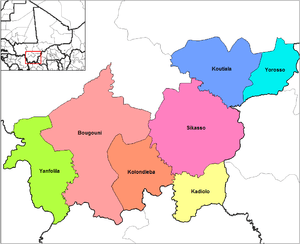Sikasso Region
Sikasso Region (Bambara: ߛߌߞߊߛߏ ߘߌߣߋߖߊ tr. Sikaso Dineja) is the southern-most region of Mali. The region's capital city, Sikasso, is the country's second-largest city and is growing rapidly due to people fleeing the violence in Côte d'Ivoire to the south. Major ethnic groups include the Senoufo, known for masks and reverence for animals, the Samago, known for being Mali's best farmers, and the main ethnic group in Mali, the Bambara people. The local economy is based on farming and the Sikasso, which receives more rain than any other Malian region, is known for its fruits and vegetables.
Sikasso Region | |
|---|---|
 Location within Mali | |
| Coordinates: 11°11′59″N 7°5′49″W | |
| Country | |
| Capital | Sikasso |
| Area | |
| • Total | 70,280 km2 (27,140 sq mi) |
| Population (2009 census)[1] | |
| • Total | 2,625,919 |
| • Density | 37/km2 (97/sq mi) |
| Time zone | UTC±0 (UTC) |
| HDI (2017) | 0.410[2] low · 3rd |
Administrative divisions

Sikasso Region is divided into seven cercles:[3][4]
| Cercle name | Area (km2) | Population Census 1998 | Population Census 2009 | |
|---|---|---|---|---|
| Bougouni | 20,028 | 307,633 | 459,509 | |
| Kadiolo | 5,375 | 130,730 | 239,713 | |
| Kolondiéba | 9,200 | 141,861 | 202,618 | |
| Koutiala | 8,740 | 382,350 | 575,253 | |
| Sikasso | 15,375 | 514,764 | 725,494 | |
| Yanfolila | 9,240 | 163,798 | 211,824 | |
| Yorosso | 5,500 | 141,021 | 211,508 | |
The city of Sikasso is known for a vibrant outdoor market which features fabrics, numerous vegetables and fruits (especially mangoes, for which Sikasso is particularly renowned.) Sikasso is an ethnic and linguistic melting pot featuring people from outlying villages, immigrants from Côte d'Ivoire and Burkina Faso and refugees.
The southwest corner of the Sikasso region is traditionally known as Wassoulou. This area is known for its unique music and strong tradition of hunting. The main city of Wassoulou is Yanfolila.
Besides the regional capital, the other urban communes and major cities in Sikasso Region are Bougouni, a junction town en route to Bamako (the capital of Mali), and Koutiala in the northern part of Sikasso Region, which is the hub of Mali's highly productive cotton industry, which produces one of the country's few exports.
See also
References
- Resultats Provisoires RGPH 2009 (Région de Sikasso) (PDF) (in French), République de Mali: Institut National de la Statistique, archived (PDF) from the original on 22 July 2011.
- "Sub-national HDI - Area Database - Global Data Lab". hdi.globaldatalab.org. Retrieved 2018-09-13.
- Loi N°99-035/ du 10 Aout 1999 Portant Création des Collectivités Territoriales de Cercles et de Régions (PDF) (in French), Ministère de l'Administration Territoriales et des Collectivités Locales, République du Mali, 1999.
- Communes de la Région de Sikasso (PDF) (in French), Ministère de l’administration territoriale et des collectivités locales, République du Mali, archived (PDF) from the original on 3 December 2013.
External links
- Site Officiel de la Région de Sikasso (in French), Ministère de l'Administration Territoriale et des Collectivités Locales, République du Mali.
- Synthèsis des Plans Communaux de Securité Alimentaire de la Région de Sikasso 2007-2011 (PDF) (in French), Commissariat à la Sécurité Alimentaire, République du Mali, USAID-Mali, 2007.
